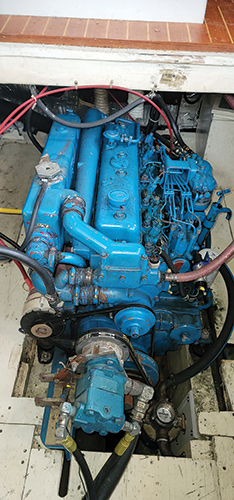
Aboard many recreational and commercial boats, the main engine may be equipped to drive more than just the boat. From pump drives to generators, the power an engine produces can be utilized in a variety of useful ways. Engines are powerhouses that convert heat energy into a useful form of work, typically from a linear up and down motion to a reciprocating motion that is easily leveraged for our needs — whether it is propelling a vessel through the water, or providing the electricity for the ship while underway. We also see fluid and heat energy being used and re-used in a fashion that is desirable for heating and cooling, pushing and pulling.
All of our engines have at least one or more accessories added to the engine for auxiliary use outside of propelling the boat in forward or reverse. These accessories typically include the bare minimum vital components such as the fresh and raw water pump to keep the engine cool, an alternator or generator to produce power for batteries or electric motors aboard the vessel, and sometimes a power take-off (PTO) shaft that transfers mechanical power from the engine and enables the addition of further accessories. On most sailboats, space is extremely limited in the engine compartment, so I don’t typically see much more than these components. However, the bigger the boat, the more accessories I see, and the engine is asked to drive various components related to hydraulic systems, compressed air systems, heating and cooling systems, charging systems, and trim systems to keep the vessel stable and comfortable.

components.
Many of these auxiliaries are driven by belts and pulleys, however some systems are chain and gear driven. I have also seen some auxiliaries in the form of plumbing to the engine via hose or pipe for transfer of coolant to cabin heaters or hot water heaters. One of the most common auxiliaries I see on the majority of boats is coolant plumbing throughout the vessel for a hot water heater, fuel heater, cabin heater, or any other form of heat exchanger used to warm something with the heat that the coolant carries away from the engine. While this is not a parasitic load on the engine, the water pump on the engine is what moves coolant through the circuit. This is extremely efficient, and actually helps the engine stay cooler as well as the coolant will have the chance to give off even more heat throughout the boat before returning to the engine block to be reused. Some engines, especially on larger yachts and commercial ships, are equipped with a PTO drive that runs a raw water bilge pump or fire pump as a backup to the main electric pumps on board.

Another common auxiliary I often see is engine-driven hydraulic or compressed air pumps for power steering, davits, hydraulic starters, trim tabs, stabilizers, air horns, other pneumatic systems, and much more. Hydraulic pressure is supplied via an engine-driven pump, whether it is attached to the crankshaft/PTO shaft of the engine, belt driven, or chain driven. Air compressors attached to the engine are most commonly gear driven, so will be found attached to the front or rear gear housing of the engine. They require a lot of space as well as a pressure reservoir so they are not typically found on small boats.
While having a variety of these auxiliaries attached to the engine is handy and saves space, we also have to keep in mind that all of these “things” are essentially a parasitic draw on the engine’s power. Adding too many auxiliary components can actually overload an engine and change its performance. If adding more than one thing, or adding something that requires a large draw on engine power (heavy duty air compressors, hydraulic pumps or alternators), you may have to beef up auxiliary shafts and pulleys by adding more belts, etc. Pay attention to engine performance and make sure you are not overworking the engine. Keep this in mind, so your engine is able to perform as intended without issue!
Remember, engines do a lot more than just propel the boat forward! A relatively compact powerhouse, usually hidden from sight, helps to keep many systems operational while underway. It is important to become familiar with these systems, to maintain them and to enjoy them.
Meredith Anderson is the owner of Meredith’s Marine Services, where she operates a mobile mechanic service and teaches hands-on marine diesel classes to groups and in private classes aboard their own vessels.






